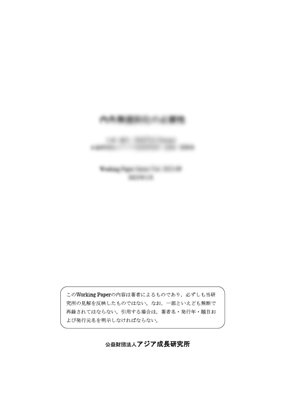Exploiting Bright Pearls Hidden in the Pandora’s Box of Japanese Urban Growth

| 執筆者 | Eui-Gak Hwang, Shoichi Yamashita, Kazuhiko Yokota |
|---|---|
| 発行年月 | 2008年 2月 |
| No. | 2008-02 |
| ダウンロード | 438KB |
内容紹介
Japanese per capita national income had grown at the average rate of around 2.0% in the last two decades, while most of the 13th largest cities in our sample grew in the range of 2.04% (Osaka) to 3.43% (Tokyo) with only exceptions of Sendai(-0.03%), Kawasaki(1.02%) and Kitakyushu (1.56%). This paper attempts to look into the growth sources of the most advanced capitalistic but idiosyncratic Japanese society. Crossurban data sets of Japan are put on the macro-anatomical table using both panel data of 13 largest cities covering 1994-2004 and time-series data of 10 cities for 1984-2004 plus one additional city Yokohama (1985-2005). Despite some mutually incongruous and diversified data sets for those cities over years, efforts for both congruent economic analysis and econometric experiments are made to identify the marginal effects of theoretically relevant key factors on the urban growth. Accounting for the urban growth and growth source analysis using Japanese urban data conforms fairly well to the conventional theory related to production function. One aspect of cultural diversity, namely the ethnic diversity partakes to produce statistically significant contribution to the growth of cities in Japan. But limited and internally inconsistent data of other important cultural factors such as religion, sports, and other cultural activities does not allow us to test their effects on urban growth, but future supplement of these data promises to be interesting path to explore further.
